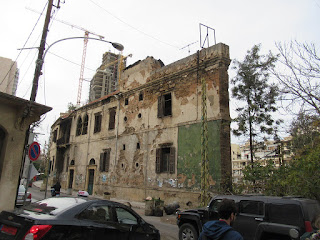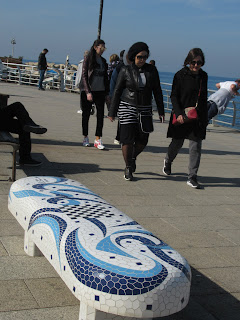Lebanon, Part II: Beirut
I was staying at the excellent Hotel Cavalier in the lively section of town called Hamra.
I spent the first part of my first day (a Sunday) walking the main street, Hamra Street, starting with a "petit déjeuner" (breakfast) that I could never again replicate and from the next day on, ate breakfast at the hotel. The particular pastries pictured below, according to my Lebanese friend Najla, are NOT the traditional "mankousheh", but rather a European version of it. Note the ashtray on the table: Smoking was outlawed in restaurants but there was such an outcry from bars that many re-allowed it, providing ashtrays that have a "no smoking" symbol on them! It's really the "shishah" or "nargileh" --the water pipe -- that the Lebanese love!
 |
 |
| Beirut's diversity is seen on every street corner; the woman on far left is wearing traditional "habesha" or Ethiopian dress. |
 | ||
Fast food traditional style...
|
 |
| Fast food both styles, side-by side. |
 |
| Food delivery... |
 |
| Food display (dried nuts and fruits everywhere!) |
 |
| Food political statement... |
 |
| Not food. Soap. |
Downhill at the end of Hamra and alongside the Ras Beirut quarter, my walk took me to the Corniche on the Mediterranean, where families, friends, couples and solos were enjoying the January sunshine -- after a week of rain (that I blissfully missed).
In the afternoon, I took the almost four-hour "WalkBeirut" tour, led by Lebanese historical and cultural narrator Ronnie Chatah. Son of an assassinated Beirut official, Ronnie ardently incorporates all his knowledge of and passion for his country -- as well as his father's vision for it -- in an engaging historical and cultural narrative (in his American-accented English). This must-do walk is not as much much about "tourist sites" as it is about the fabric of Beirut's history, heritage and current affairs. Ronnie probes beneath the surface to reveal and impart the subtleties that are essential to even begin to understand this complex and fascinating land.
 |
| ....though upkeep is expensive, and so traditional styles may be found side-by-side with less diligently maintained properties. |
 |
| ...and keep going to the end of the street to the former notorious civil war's "Green Line", where bombed out remains still stand... |
Also in downtown, the former Jewish Quarter (Wadi Abu Jmeel in Arabic) has been razed and readied for new development by the controversial company, Solidere, which has the contract for re-doing the once entire battle-scarred downtown.
|
 |
 |
| ...after renovation (this is what I saw) |
Solidere's renovated, rebuilt downtown Beirut is glitzy, high-end and fashionable, though funded by money of questionable sources, built on top of priceless archaeological sites (though a portion of the Roman Baths have been excavated), sometimes next to French mandate-era buildings and, in my opinion, devoid of character, history, and spirit. The Disneyland-like "Place de l'Etoile" has streets in which children can freely play, as no traffic is allowed, and a clock tower boasting its sponsor: Rolex.
 |
| Also on the square is the renovated Greek Orthodox St. George Cathedral, next door to... |
 |
| ...the Sunni Mohammad Al-Amin Mosque... |
 |
| ...which is just a few streets away from the Maronite (Christian) St. George Cathedral am (I didn't take a picture; one below is from internet).  |
The next-to-last stop on the walk was Martyr's Square (also pictured at beginning of this blog post), in memory of Lebanese nationalists murdered by the Ottomans in 1915, and site of the so-called "Cedar Revolution"in 2005, calling for the truth about the assassination of then prime minister Rafiq Hariri and an end to the Syrian military presence in Lebanon (well, yes, even though they are "cousins", one can take just so much of interfering family members...).
Tour leader Ronnie used this opportunity to recite a moving tribute to his father, and his father's vision of Lebanon. I was sitting next to Ronnie's mother, who was on his tour for the first time in the 10 years he has been giving it, and her eyes filled with tears as she listened to her son's moving and eloquent homage to her late husband.
And the final stop was Samir Kassir Garden, in commemoration of the Lebanese-French professor and journalist who was one of numerous Lebanese public figures assassinated during the 2000's.
***
On day #2, Monday, thanks to my D.C. friend Mary who had studied and lived in Beirut, I had appointments to meet three people, the first two at the American University of Beirut, indeed one of the world's premier academic institutions. The walk to the campus, in the Ras Beirut quarter, took me only a few minutes, enabling me to see more of Beirut's street life and mix of modern and traditional, new and old architecture:
Approaching the campus on well-known Bliss Street (and am currently reading a delightful novel by the same name by Kris Kenway)...
And out of Beirut's madness into the beautiful oasis of the AUB campus...
...to the jarringly contemporary but architecturally symbolic Issam Fares Institute for Public Policy and International Affairs, where I met with the Director Research who coordinates the university's some 72 Syrian refugee-oriented projects...
Next was a meeting with Dr. Leila Badre, one of the country's pre-eminent archaeologists and director of the AUB Archaeology Museum:
And then a delightful lunch back in Hamra (just across the street from my hotel, as it happened) with Grace Said. The younger sister of the late eminent Palestinian scholar Dr. Edward Said, Grace is a pro-Palestinian peace and justice activist who had recently returned to Lebanon from Washington, D.C. where she'd lived for 30 years, and from where she knows both my "Lebanese connection"friends, Najla and Mary.
In the afternoon, I decided to check out the showroom of INAASH, the organization that sells articles hand-embroidered by Palestinian refugees, and with which Grace works as a volunteer consultant. Their Hamra showroom is difficult to find, at the end of the main street but then left at the alley, and then upstairs in a somewhat rundown building at the end of a cul-de-sac. ...but there was nothing "derelict" about the artifacts! Exquisitely made, and regrettably, much more expensive than I'd anticipated or that my "souvenir" budget would allow. I had a nice chat, though, with the manager, who explained the cost/pricing structure, and noted that the shelves that day were light on product because much of the inventory was en route to a show in the Gulf States.Disappointed that I couldn't buy a really nice Palestinian-embroidered piece, I soothed my souvenir-driven soul with a purchase of a perfumed essential oil in "Arabian"packaging:
I did not, however, avail myself of the goods in this shop. It is always a surprise to see these "sexy" underthings in shop windows in "conservative"Muslim countries -- and even more surprising to see that the salespeople are typically men!
I did go to the National Museum in Beirut, but not until the next-to-last day of my visit. Filled with archaeological treasures from over 7,000 years, all excavated in Lebanon, the museum was completed renovated and its priceless artifacts saved with skilled and loving restoration following the museum's near destruction during the civil war. I didn't take my camera that day, and the museum's website is under construction (well, as is everything in Beirut!), but I did find these pictures on the internet:

 |
| And this article describes how this post-conflict wreck... |
 |
| was turned into this. |
***
Next chapter: Jeita Grotto, Harissa, and Byblos



































































So Interesting - and impressive! The links you provide are also very interesting. Thank you for sharing your adventures.
ReplyDeleteTrès enrichissant ce séjour à Beyrouth, avec beaucoup d'explications ciblées. Les photos sont très diversifiées et précises selon le thème. Bravo Paulette!
ReplyDelete